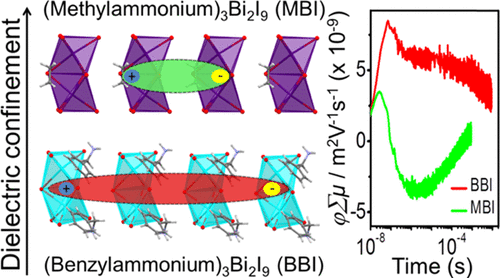当前位置:
X-MOL 学术
›
Chem. Mater.
›
论文详情
Our official English website, www.x-mol.net, welcomes your
feedback! (Note: you will need to create a separate account there.)
Bismuth-Based Zero-Dimensional Perovskite-like Materials: Effect of Benzylammonium on Dielectric Confinement and Photoconductivity
Chemistry of Materials ( IF 7.2 ) Pub Date : 2020-03-02 , DOI: 10.1021/acs.chemmater.0c00390 Johnpaul K. Pious 1, 2 , Chinnadurai Muthu 1, 2 , Selgiya Dani 1 , Akinori Saeki 3 , Vijayakumar C. Nair 1, 2
Chemistry of Materials ( IF 7.2 ) Pub Date : 2020-03-02 , DOI: 10.1021/acs.chemmater.0c00390 Johnpaul K. Pious 1, 2 , Chinnadurai Muthu 1, 2 , Selgiya Dani 1 , Akinori Saeki 3 , Vijayakumar C. Nair 1, 2
Affiliation

|
Bismuth-based perovskite-like materials are considered as promising alternatives to lead-based perovskites for optoelectronic applications. However, the major drawbacks of these materials are high exciton binding energy and poor charge-carrier separation efficiency. These issues are attributed to the strong quantum and dielectric confinements associated with these materials. In this work, we have used a simple methodology to reduce the dielectric confinement in hybrid A3Bi2I9 type perovskite-like materials (A is an organic cation) to improve the charge-carrier separation efficiency. For that, the electronically inert methylammonium (MA) was replaced with a polarizable benzylammonium (BA) cation in the well-studied MA3Bi2I9 (MBI) structure. The single-crystal X-ray diffraction (XRD) and ultraviolet–visible (UV–vis) absorption spectroscopy analyses suggested similar quantum confinement in both (BA)3Bi2I9 (BBI) and MBI materials. This enabled us to precisely investigate the role of polarizable benzylammonium cations in the dielectric confinement in BBI. Flash-photolysis time-resolved microwave conductivity studies revealed about 2.5-fold enhancement of φ∑μ (the product of charge-carrier generation quantum yield and the sum of charge-carrier mobilities) for BBI when compared to that of MBI, which is attributed to the low dielectric confinement in the former.
中文翻译:

铋基零维钙钛矿样材料:苄基铵对介电限制和光电导的影响
铋基钙钛矿状材料被认为是光电子应用中铅基钙钛矿的有前途的替代品。然而,这些材料的主要缺点是高激子结合能和差的电荷-载流子分离效率。这些问题归因于与这些材料相关的强量子和电介质限制。在这项工作中,我们使用了一种简单的方法来减少杂化A 3 Bi 2 I 9型钙钛矿状材料(A是有机阳离子)中的介电限制,以提高电荷-载流子分离效率。为此,在经过充分研究的MA 3 Bi 2中,将电子惰性甲基铵(MA)替换为可极化的苄基铵(BA)阳离子。I 9(MBI)结构。单晶X射线衍射(XRD)和紫外可见(UV-vis)吸收光谱分析表明(BA)3 Bi 2 I 9(BBI)和MBI材料具有相似的量子限制。这使我们能够精确地研究可极化的苄基铵阳离子在BBI介质限制中的作用。闪烁光解时间分辨的微波电导率研究表明,与MBI相比,BBI的φ∑μ(电荷载流子生成量子产率与电荷载流子迁移率总和的乘积)提高了约2.5倍,这归因于到前者的低电介质限制。
更新日期:2020-03-03
中文翻译:

铋基零维钙钛矿样材料:苄基铵对介电限制和光电导的影响
铋基钙钛矿状材料被认为是光电子应用中铅基钙钛矿的有前途的替代品。然而,这些材料的主要缺点是高激子结合能和差的电荷-载流子分离效率。这些问题归因于与这些材料相关的强量子和电介质限制。在这项工作中,我们使用了一种简单的方法来减少杂化A 3 Bi 2 I 9型钙钛矿状材料(A是有机阳离子)中的介电限制,以提高电荷-载流子分离效率。为此,在经过充分研究的MA 3 Bi 2中,将电子惰性甲基铵(MA)替换为可极化的苄基铵(BA)阳离子。I 9(MBI)结构。单晶X射线衍射(XRD)和紫外可见(UV-vis)吸收光谱分析表明(BA)3 Bi 2 I 9(BBI)和MBI材料具有相似的量子限制。这使我们能够精确地研究可极化的苄基铵阳离子在BBI介质限制中的作用。闪烁光解时间分辨的微波电导率研究表明,与MBI相比,BBI的φ∑μ(电荷载流子生成量子产率与电荷载流子迁移率总和的乘积)提高了约2.5倍,这归因于到前者的低电介质限制。


















































 京公网安备 11010802027423号
京公网安备 11010802027423号